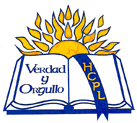VERDAD y ORGULLO TRUTH AND PRIDE
“ Come, noble soldiers, knights of Christ, here is presented the first opportunity for you to show your mettle and courage and to prove that you are deserving of the glories in store for you.” don Juan de Oñate
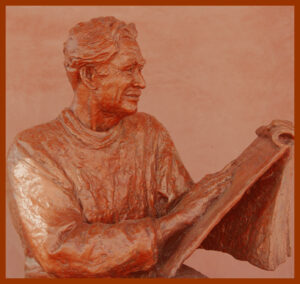
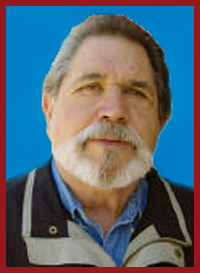
Dón Reynaldo “Sonny” Rivera 2011 Adelantado
Reynaldo “Sonny” Rivera, a native of Mesquite, New Mexico was born in 1938. He is the son of Natalia and Alexander Rivera, a World War I veteran. Rivera joined the U.S. Navy at the age of 17, and spent four years touring the world, a time that brought him into contact with different cultures and world-class museums. After the service he enjoyed a very successful career as a barber-hairstylist; however, his first love was always art. So at age forty he went off to art school in Chicago, and later continued his education in Italy, Mexico, and Scottsdale, Arizona.
Rivera’s creativity knows no bounds. With over 40 public art commissions to his credit, Rivera’s principal public art works have included historical and modern-day themes such as the Spanish colonizers of New Mexico at the Albuquerque Museum; the Santa Fe Trail sculpture at Museum Hill in Santa Fe; a “9-11 Memorial” for the city of Broomfield, Colorado; a Korean War Medal of Honor recipient for the VA Medical Center in Albuquerque; and a monumental bronze sculpture of world renowned author Rudolfo Anaya for the City of Santa Rosa, New Mexico. Reynaldo’s most recent accomplishment is a 14′ monumental bronze sculpture of Cave Explorer, Jim White for the City of Carlsbad.
His historical, spiritual, and life-affirming themes have made this son of Mesquite, New Mexico a world renowned artist. He is indeed a national treasure that New Mexico is proud to call her own.
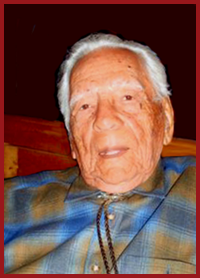
Dón Antonio “Tony” Garcia 2010 Adelantado NM HISTORIC PRESERVATIONIST
His passion and recognition of the vitally important History of Spanish New Mexico, as held within the material objects of those times during the founding, formation and settlement periods, was something Garcia did not want to see lost.. In the 40’s he began to travel the state to seriously hunt and collect artifacts. For a span of over 40 years, Garcia assembled probably the largest collection of New Mexico Spanish Provincial artifacts made in the 1700’s through 1800’s. Garcia’s friends and family often saw him drive up with his pick up loaded with New Mexico trasteros, grain boxes, old doors, and many other artifacts, many of which he collected for the museum in Santa Fe early on.
It was not until meeting Dr Ward Alan Minge in 1952, who had purchased Casa San Ysidro and wanted to use older and handmade doors, windows and early NM kind items in the restoration and additions did the two jointly saved and preserved much of what is now a part of Casa San Ysidro, as well a much in the Spanish Colonial Museum in Santa Fe were finds of Garcia.
Dr. Minge and Dón Antonio (Tony), agreed that the many artifacts found would not leave New Mexico, but would remain where they should, here in Casa San Ysidro or the Spanish Colonial Museum in Santa Fe. What was pleasing was that collections found in Rio Abajo could now stay, in the Casa San Ysidro, once completed.
Garcia married his wife Mini, and now lives with daughter Loretta, in Alameda, among two loving grandsons, Rick and Robert Sanchez. At 98 he remains healthy and interested in all things.. He also has several great-grandchildren and all keeping him busy. Garcia served seven years in the Army, has been a life time member of the Disabled American Veterans, after receiving a service connected disability from WWII .in Santa Fe.
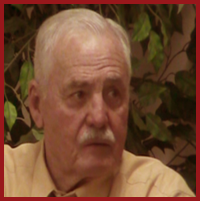
Robert Himmerich y Valencia, Ph.D. 2009 Adelantado Historian, Professor, Writer
Robert Himmerich y Valencia wrote Encomenderos of New Spain, 1521-1555 that was published by the University of Texas Press in 1991. He painstakingly culled through most of the secondary and some of the available primary sources resulting in a pioneering effort to identify the first encomenderos of New Spain. Robert examined 506 encomenderos in Mexico and examined the implications of the encomendia in colonial Mexican history and culture including ownership and distribution patterns.
Many records were destroyed and those that remain in the Archivo General de la Nación in Mexico City are rich in notarial documents, but contained little about the lives of the encomenderos. Many of the names mentioned in the book are found in New Mexico, such as Garcia, Lucero, Griego, Romero, Sanchez, Gonzales, Gonzalez, etc…The book explores backgrounds, regional origins social standing and experience.
Robert’s book is an important reference tool for scholars working on the early colonial period of Mexico and is destined to become a classic. New Mexicans will find it informative as it contains many names we are familiar with and there are probably many antepasados listed in the book.
Robert was Editor of the New Mexico Historical Review and Associate, Director for Academic Programs at the Latin American Institute at UNM. He held the position of Adjunct Faculty at Pepperdine Unversity in Malibu, California.
Robert has a PhD in History from the University of California, Los Angeles. He has taught for over 28 years as either as an instructor, lecturer or professor and subjects included Latin America, the United States or World Civilizations.
Robert had a 23 year career in the US Marine Corps and retired as a Major and served in combat duty in Korea and Vietnam. He served as commanding officer of communications-electronics, aviation, and infantry organizations with up to 670 officers and enlisted personnel. As staff officer for logistics, operations. maintenance and communication-electronics he developed and administered multi-million dollar budgets for procurement, operations, maintenance and training.
He has served in many boards including the Museum of New Mexico Foundation, Federation of State Humanities Councils, NM Endowment for the Humanities, Santa Fe Fiesta Foundation and El Rancho de las Golondrinas.
After so many years of travel, hard work and war he is a gentleman farmer at Santo Bueno Ranch in Peña Blanca, NM. His antepasados would be proud.
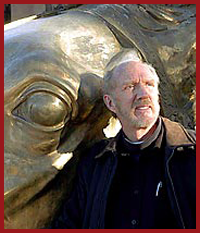
2009 winner John Sherrill Houser 2009 El Adelantado Sculptor and Painter
John and his son Ethan are the creators of the world’s largest equestrian, bronze statue depicting don Juan de Oñate at El Paso del Rio del Norte in 1598. It has been installed at the entrance to the International Airport in El Paso, Texas.
This colossal sculpture is 36’ high and weighs 20 tons and required ten years to complete. It was enlarged in Mexico City and cast at Shidoni Foundry in Tesuque north of Santa Fe. It was shipped to Wyoming where the armature was built, the patina was applied and the pieces were assembled. It was then partially disassembled and transported to the El Paso airport for installation in September of 2006.
John Houser was born in South Dakota where his father was assistant sculptor in the carving of Mt. Rushmore. John’s mastery of painting and sculpture is unique. Apart from monumental commissions and studio sculpture (including portraiture), he is also an award-winning painter of landscapes, still life and the figure. He has exhibited in the United States and abroad. His work is in prominent collections including the US Library of Congress, Greenshields Museum (Montreal), The Southwest Museum (Los Angeles), Forest Hills Trust (Boston), Arizona State Museum (Tucson), and the Portland Museum of Fine Arts (Oregon). His art has been featured in The New York Times, London Sunday Telegraph, ABC (Spain), Der Spiegel (Germany), Southwest Art, Connoisseur Magazine, Artes de Mexico magazine and The Houston Chronicle. He is a Professional member of National Sculpture Society.
John studied and traveled extensively throughout the United States, Mexico and Spain where he conducted artistic and historical studies. Houser found a large, handsome Andalusian stallion for his model in the El Paso area and one for the rider in Madrid, Spain. Don Manuel Gullón y de Oñate, Conde de Tepa, a descendant of the colonizer became the model for Oñate.
Sculptors say that the horse is the most difficult subject, and the greatest challenge is to create a colossal rearing horse. Houser ambitiously accepted the challenge and added a mounted rider. When asked why such a big horse, he replied. “ A well-modeled powerful horse, on a gigantic scale, will make people aware of the nation’s rich Hispanic heritage and of the horse’s important contribution to the American West”.
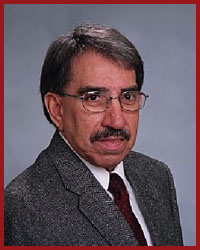
Ronaldo Miera 2008 Adelantado
Ronaldo Miera is a native New Mexican, who was born in San Antonio a small farming community on the Camino Real, later his family moved to Alburquerque. Mr. Miera attended St. Mary Elementary and graduated from St Mary High. A year after graduation Mr. Miera joined the United States Army, and was sent to Western Germany. He spent the rest of his enlistment in Germany and was discharged in January 1964.
Ron holds a degree in Electro-Mechanical Drafting Technology and retired from the Postal Service where he held the position of Denver Regional National Business Agent, Maintenance Division. After his retirement Mr. Miera joined the National Association of Retired Federal Employees Chapter 80 in Alburquerque, and was elected to the position of Vice President through 1994.
Currently Ron is President of the Hispanic Genealogical Research Center of New Mexico, a post he has held since 1994. During his tenure the HGRC has: published 57 Herencias, (a quarterly journal), 61 books of extracted sacramental records, has a monthly speakers program and has video recorded most of the speakers for the HGRC archives. In 1997 the HGRC added the Great New Mexico Pedigree Database to its web site which now contains over 100,000 names.
Mr. Miera lobbied the New Mexico State legislature on behalf of HGRC in 1998 to obtain a grant to publish the seminal book “The Spanish Recolonization of New Mexico” authored by Jose Antonio Esquibel and John Colligan. Also in 1998 Mr. Miera learned that the book “Origins of New Mexico Families” by Fray Angelico Chavez” is a major key to Hispanic families’ genealogy research. The Museum of New Mexico Press, a division of the Office of Cultural Affairs, holds the copyright and publishing rights to the book and has twice been reluctant to reprint the book. Mr. Miera met with two Governors to resolve the problem.
In 1999 don Ronaldo was instrumental in persuading Bishop Donald Pelotte, Bishop of the Gallup Diocese, into microfilming the sacramental records of the Gallup Diocese. The diocese had in their possession records with a starting date of 1777 to the present. The Bishop agreed to have the Diocese records from 1777 to 1922 microfilmed. With a grant from the New Mexico State Records Center the microfilming project started in early 2000. With the training and help from the employees at the record center the HGRC volunteers were able to complete the project in the fall of 2000.
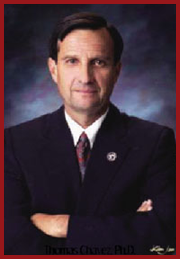
Dr. Tom Chávez 2007 El Adelantado
Dr. Tom Chávez, was selected primarily for his book, Spain and the Independence of the United States. It is a subject that most Americans, including Hispanics, know little about because it is not taught in our schools. The information in the book is considered so valuable that the book has been translated into Spanish and is being sold in Spain. The League has promoted this book by giving copies to schoolteachers and has asked memb ers to give copies as gifts. Tom researched and wrote the book and then enlisted an unlikely group to recognize and support it, the Daughters of the American Revolution! They not only embraced the subject, they published a special edition of their magazine and it was distributed nationally to their membership. They created a special recognition for Hispanic Daughters and Sons of the American Revolution for those who served and donated to the Battle for Independence. There are two in New Mexico, Eva Torres Aschenbrener (NMHCPL Doña Eufemia) from Santa Fé and Charles Martinez, genealogist, from Espanola. The DAR also presented a plaque recognizing the participation of Hispanic New Mexicans, which is mounted at the National Hispanic Cultural Center. Dr Chávez is also former Director of the National Hispanic Cultural Center and the Palace of the Governors in Santa Fé.
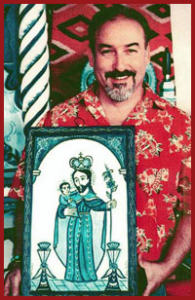
Charlie Carillo 2006 Adelantado
Charlie is well known to most of us as an accomplished santero. His art is displayed in many major museums including the Smithsonian in Washington DC.
He is a New Mexico native and has mentored other artists and given free classes at places such as Rancho de las Golondrinas and has reintroduced traditional methods by sharing his wisdom, faith and techniques. This new generation of Santeros and other Hispanic artisans has led to a renaissance of Hispanic Art in recent years.
He has a Masters degree and a PHD in Anthropology from UNM. He discovered his destiny during an architectural dig he was directing at La Capilla de Santa Rosa de Lima in Abiquiú in 1977. It was here where he rediscovered much of his cultural heritage.
As an apprentice with the Morada at Abiquiú, he became infatuated with the Spanish Colonial religious artifacts, their symbolism and the cultural heritage of Northern New Mexico and is now a leading member of the Brotherhood of La Morada de Nuestra Señora de Dolores del Alto de Abiquiú.
What began as historical research into the area and the retablos and bultos, became his destiny as a world famous Santero. Charlie is the consummate Santero in that he not only creates the actual artwork and practices the faith behind each piece. He is also passing on the tradition for future generations.
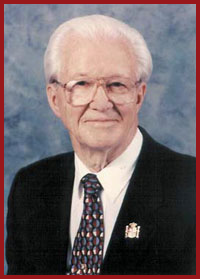
Sheldon Hall 2005 El Adelantado
Why we have chosen this man from El Paso Texas for the honor of Adelantado. Sheldon arranged a meeting with NMHCPL officers during the controversy in El Paso’s to rename artist John Houser’s, worlds largest equestrian statue of don Juan de Oñate. Sheldon made it a research project to disprove comments made at city council against don Juan de Oñate. He hoped to enlist our help contacting the media in response to anti- Oñate rhetoric. He traveled to part of Mexico taking pictures of existing don Juan de Oñate statues, where none exist he talked to mayors planting the seed.
It was at this meeting that the famous Jose Cisneros with tears in his eyes said “Sheldon Hall has done more for Hispanics and he has done it with his own money, he is the best friend Hispanics have”.
We set out to find out just who this friend of Hispanics is and it did not take very long to realize that Sheldon Hall truly deserves the honor.
Although he is not Hispanic he has a deep appreciation for our history and culture. This was made evident when he convinced the Texas Legislature to add the study of Galvez to the history textbooks and studies of the Spanish colonial southwest. The changes he brought about actually had an effect on California too because they buy their books from the same distributor.
He is involved in the Twelve Travelers an organization in El Paso, Texas. They focus on the preservation of the historical past blending art, education and tourism. The organization works to depict historical figures including the 35foot high statue of Oñate that will be installed at the airport and will be a tremendous educational tool for the nation and the southwest.
Sheldon went to Spain to get authentic Spanish colonial uniforms for the annual Thanksgiving celebration depicting 1598 arrival of the settlers and don Juan de Oñate.
When Sheldon was visiting the Texas state museum he noticed derogatory comment about don Juan de Oñate. He visited with the director and was told if he could get a noted historian to write and back up facts they would change the text. Sheldon reached out to John Kessell who supplied the museum with factual text.
The Mission Trail Association, was founded by the association’s president Sheldon Hall. This was not just a matter of restoring crumbling buildings in Socorro, San Elizario, and Ysleta — which lie south of El Paso along the Texas/Mexico border but also educating the public. The San Elizario Presidio Chapel is considered to be the largest of the three churches on the El Paso Mission Trail, and was the site of the first military post in the United States. The Association in addition to claiming the first settlements in the United States, El Paso County boasts the first Thanksgiving. Don Juan de Oñate, the son of a noble Spanish family, lead an expedition of colonists from Santa Barbara, Mexico, through the desert to El Paso in 1598 (First Thanksgiving). The settlers paused from their long journey along the Rio Grande River at San Elizario. Though today, the site is believed to be near the present-day Socorro. There, Oñate ordered a feast of Thanksgiving, declaring La Toma, or the claiming of the land for the King of Spain. A large feast was prepared in celebration of this event, which occurred 23 years prior to the feast at Plymouth Rock. To commemorate this event, the Mission Trail Association established an annual First Thanksgiving Festival, which includes a re-enactment of the arrival of Oñate on the banks of the Rio Grande. The first commemorative festival took place in 1989, involving over seventy volunteers dressed as conquistadors, soldiers and colonists, hauling wooden carts, horses, and other livestock. The association also promoted children’s books about the First Thanksgiving both in Spanish and English. Ambitious don’t you think?
He has received many honors including Honorary Consul of Spain and the Cruz de la Orden de Isabel la Catolica, presented by the King of Spain in 1989.
He was President of Caballeros de Oñate and Granaderos de Galvez. Both groups worked to promote Hispanic culture and contributions. Hall used his own resources to provide horses and authentic costumes and travel funds to promote Hispanic history.
Aldelantado Sheldon Hall has lead the way on many projects and does not take no for an answer, he asks why not. I know you will agree this soft-spoken gentleman is a man of honor and conviction he is truly a friend to Hispanos.
Sheldon Hall 2005 El Adelantado
Why we have chosen this man from El Paso Texas for the honor of Adelantado. Sheldon arranged a meeting with NMHCPL officers during the controversy in El Paso’s to rename artist John Houser’s, worlds largest equestrian statue of don Juan de Oñate. Sheldon made it a research project to disprove comments made at city council against don Juan de Oñate. He hoped to enlist our help contacting the media in response to anti- Oñate rhetoric. He traveled to part of Mexico taking pictures of existing don Juan de Oñate statues, where none exist he talked to mayors planting the seed.
It was at this meeting that the famous Jose Cisneros with tears in his eyes said “Sheldon Hall has done more for Hispanics and he has done it with his own money, he is the best friend Hispanics have”.
We set out to find out just who this friend of Hispanics is and it did not take very long to realize that Sheldon Hall truly deserves the honor.
Although he is not Hispanic he has a deep appreciation for our history and culture. This was made evident when he convinced the Texas Legislature to add the study of Galvez to the history textbooks and studies of the Spanish colonial southwest. The changes he brought about actually had an effect on California too because they buy their books from the same distributor.
He is involved in the Twelve Travelers an organization in El Paso, Texas. They focus on the preservation of the historical past blending art, education and tourism. The organization works to depict historical figures including the 35foot high statue of Oñate that will be installed at the airport and will be a tremendous educational tool for the nation and the southwest.
Sheldon went to Spain to get authentic Spanish colonial uniforms for the annual Thanksgiving celebration depicting 1598 arrival of the settlers and don Juan de Oñate.
When Sheldon was visiting the Texas state museum he noticed derogatory comment about don Juan de Oñate. He visited with the director and was told if he could get a noted historian to write and back up facts they would change the text. Sheldon reached out to John Kessell who supplied the museum with factual text.
The Mission Trail Association, was founded by the association’s president Sheldon Hall. This was not just a matter of restoring crumbling buildings in Socorro, San Elizario, and Ysleta — which lie south of El Paso along the Texas/Mexico border but also educating the public. The San Elizario Presidio Chapel is considered to be the largest of the three churches on the El Paso Mission Trail, and was the site of the first military post in the United States. The Association in addition to claiming the first settlements in the United States, El Paso County boasts the first Thanksgiving. Don Juan de Oñate, the son of a noble Spanish family, lead an expedition of colonists from Santa Barbara, Mexico, through the desert to El Paso in 1598 (First Thanksgiving). The settlers paused from their long journey along the Rio Grande River at San Elizario. Though today, the site is believed to be near the present-day Socorro. There, Oñate ordered a feast of Thanksgiving, declaring La Toma, or the claiming of the land for the King of Spain. A large feast was prepared in celebration of this event, which occurred 23 years prior to the feast at Plymouth Rock. To commemorate this event, the Mission Trail Association established an annual First Thanksgiving Festival, which includes a re-enactment of the arrival of Oñate on the banks of the Rio Grande. The first commemorative festival took place in 1989, involving over seventy volunteers dressed as conquistadors, soldiers and colonists, hauling wooden carts, horses, and other livestock. The association also promoted children’s books about the First Thanksgiving both in Spanish and English. Ambitious don’t you think?
He has received many honors including Honorary Consul of Spain and the Cruz de la Orden de Isabel la Catolica, presented by the King of Spain in 1989.
He was President of Caballeros de Oñate and Granaderos de Galvez. Both groups worked to promote Hispanic culture and contributions. Hall used his own resources to provide horses and authentic costumes and travel funds to promote Hispanic history.
Aldelantado Sheldon Hall has lead the way on many projects and does not take no for an answer, he asks why not. I know you will agree this soft-spoken gentleman is a man of honor and conviction he is truly a friend to Hispanos.
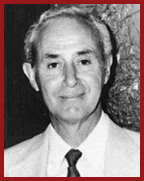
Ambassador Frank V. Ortiz, 2004 El Adelantado
Ambassador and crusader, Ambassador Ortiz is a native of Santa Fé and is a member of prominent families that for generations have been involved in many fields of public service. During his diplomatic career, Ambassador Ortiz served as US Ambassador to Barbados-Grenada, Guatemala, Perú and Argentina. In 1990, after forty years in the American Diplomatic Service, he and his wife Dolores Duke Avila-Landa returned to Santa Fé. He has led the battles for cultural respect. He was adamant about the respect for Our Lady of Guadalupe and warned the museum board that the community would not tolerate their insensitivity to her. He led the charge to get state funds for the Governors’ Palace Annex in an effort to protect our patrimony. When there was opposition to La Conquistadora at the top of the Cathedral Park Monument, he told them that she is an historic figure and refused to omit her. He served on many high profile boards and commissions including the Palace of the Governors, Museum of New Mexico, El Rancho de Las Golondrinas and more, in order to promote and protect our New Mexico Spanish colonial history. He passed away in 2005. Read his autobiography, Ambassador Ortiz, Lessons from a life of Service.
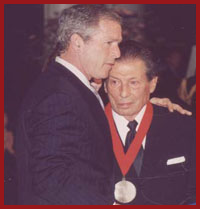
Jose Cisneros 2003 El Adelantado Award
Speech given by David Schneider
It is an honor to be able to say a few words about Jose Cisneros: artist, historian, and role model.
Jose has been honored by: Popes, Princes, and Presidents. Over the last sixty plus years his work has appeared in hundreds of periodicals and books. He hit the ground running with his early books such as Cleve Hallenbeck’s “Journey of Fray Marcos” in 1949, which won numerous awards.
Since then his art graced the pages of authors very familiar to us: Angelico Chavez’ “Origin of New Mexican Families”, Paul Horgan’s “Conquistadors in North American History”, Felix Almaraz’ “Tragic Cavalier”, & Marc Simmons’ “Last Conquistador”. Just Last year, his work appeared in John Kessell’s best selling book “Spain in the Southwest”. Felix is of course, with us here tonight as is Marc Simmons, & John Kessell.
Certainly these works are a testament to Jose Cisneros and his preservation of Hispanic culture. But, ladies and gentlemen, Jose is so much more than pen, ink and paper. He is a role model for all of us to follow.
In spite of all his awards and honors, he remains a very quiet, soft spoken, humble, and God fearing man. When others praise him he is quick to credit those who helped him along the way. He is trusting, and loyal, I have never heard him say anything negative about anyone
Along the way there have been many stumbling blocks, and may sorrows. Jose’s steadfast faith in God has never wavered. Whether we are in MSGR. Luceros office in Old Town or whether we are at Hooky’s restaurant having carnitas and tequila in El Paso, Jose is never too proud to clasp hand and give thanks to God.
If I could choose one word to describe Jose, it would be love. Love for his work, love for his fellow man, love for his Family, and love for God.
Jose will be ninety-three this Good Friday. When it comes to to providing a model as to how we should live our lives as well as maintaining and preserving Hispanic culture and pride – no one has ever done it better.
“An Artist’s Journey”, written by John O. West best describes the life of don José Cisneros and his talent. He is truly a giant of our times.
Don José Cisneros was born at Villa Ocampo, a village in northern Mexico, on April 18, 1910. His father was a descendant of the original Spanish settlers in that area. He was the owner of a ranchito but also earned a living as a carpenter and blacksmith. During the Mexican Revolution the Cisneros family was driven from their home losing everything.
Don José did not let circumstances defeat him instead he rose to meet the challenges. One example of his accomplishment was as a boy he taught himself to read. Formal schooling was arranged by one of José’s relatives from Allende when he heard about this young man’s drive. Allende is near the point of origin for expeditions led by Spanish Conquistador don Juan de Onate and don Antonio de Espejo. This set the stage for José’s destiny for he would certainly become an Adelantado of our time by keeping the historic lore alive through the images he would research and the beautiful art work he would create for future generations. His illustration would fill the void and lack of art depicting our Spanish ancestors who settled this
land, in a way he recorded their history as if he had been there. Don Jose’s early art was done in pen and ink. As always he challenged himself as he developed his skills which would blossom as he mastered the art of water color overcoming his colorblind handicap. How appropriate that his interest as those of our forefathers be of the beauty and grace of the noble horse which transported the Conquistadores and pobladores across this New World.
The Spanish Colonial period with it’s the historical figures have come alive through his art and research. According to Sheldon Hall “He’s the bestknown illustrator of the Spanish Colonial times.”
The University of Texas at El Paso has in it permanent collection exhibition over 100 equestrian drawings depicting history of the southwest during the past 400 years. Don José prides himself in good research so that his art is accurate. He used books about horses and costuming, historical reports, talked to historians and researched in libraries to learn more about the people he draws. Historians and book publishers recognized his expertise; his illustrations are in more than sixty books. During his career he created thousands of pen and ink drawings.
Don José is considered a master of pen & ink. During the Cuartrocentenario, Cisneros created a series of 10 colored pen & ink entitled “Entrada, from the Robledos to the Bosque” which was displayed in El Paso.
Don José has had his work commissioned by countless art collectors and world leaders in the United States, Europe and Mexico. His illustrations are in: Spanish embassies, the White House, the Capital of Texas where he was also given the key to the city of Austin and he has also been awarded the Cisneros medal from the University of Alcala, Spain (only four individuals outside of Spain have been awarded this honor). The beautiful tiles in Santa Fe’s Photo Archives near the Palace of the Governors are don José creations. Don José Cisneros day was declared in New Mexico January 29, 2002 as we celebrated the El Camino Real and he was also been given the key to Santa Fe.
José’s awards include:
National Humanities Medal 2002, the award was presented by President George W. Bush April 22, 2002 in Washington DC
Knighted by Popé Paul II
Don José has been Knighted by the King of Spain, Juan Carlos for his contribution to understanding history through his art.
Honored in Texas for his contribution to historical art in the Southwest by He has been named a Living legend by Westerners-International
Winner of the Historical Society of New Mexico’s Ralph Emerson Twitchell Award for significant contribution to history in the area of fine arts Border Regional Library Association Southwest Book award J.Frank Dobie fellowship 1969
Books written about don José Cisneros
“Riders Across the Centuries” Texas Western Press book 1984 “Jose Cisneros An Artists Journey” by John O. West
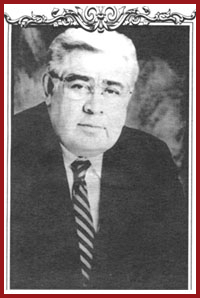
Don Eduardo Romero, 2002 El Adelantado
Ambassador Edward L. Romero was appointed by President Clinton on June 1, 1998 to serve both Spain and Andorra. After confirmation by the United States Senate, he presented his credentials to King Juan Carlos. His ancestors arrived in North America in 1598 and he has traced his family to Corral de Almaguer, Spain, where the plaza is named after him. In addition to his business success, he is a well-known leader in the hispanic community. He is a co-founder of the National Hispanic Cultural Center, served on the President’s Hispanic Advisory Committee, was a founding member of the Alburquerque Hispano Chamber of Commerce and served on the board of directors of the Congressional Hispanic Caucus Institute. King Juan Carlos bestowed the Gran Cruz de Isabel la Catolica on Ambassador Romero in 2001. Other Spanish honors include Knight of the Order of the Holy Sepulchre of Jerusalem, Honorary Brother of the International Brotherhood of Researchers, Noble Honorary Brother of the Illustrious and Most Ancient Brotherhood of Mozarabic Knights and many more. New Mexicans had a once-in-a-lifetime opportunity to visit the Embassy in Madrid during his term and he graciously hosted all who came.
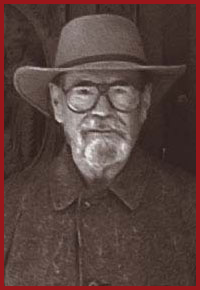
Don Pedro Ribera Ortega, 2001 El Adelantado
Pedro of Santa Fe first received his education in his culture, history and languages from his family, as his grandparents were famous decidores (story tellers). He was schooled further by the Sisters of Loretto and later received a Masters Degree in the Spanish language. He taught Spanish, Latin, and history in Santa Fe for 30 years. He was able to bring his own pride and enthusiasm to Spanish culture and history. His pride and joy was the Truchas Teachers Research Center which he founded and has thousands of books and related materials. He was a lifetime member of both the Caballeros De Vargas and La Cofradía de La Conquistadora. Due to his devotion to Our Lady, he worked to extend Fray Angelico Chaves’ research on her origin and has written many books on New Mexican culture and history. As a member of Sister Cities he acted as Ambassador to Santa Fe de La Viega and Granada, Spain. Pedro was a member of the Fiesta Council, played a major role in the Cuartocentenario activities in Santa Fe. He was named by the State of New Mexico as a Living Treasure and received an award for literary excellence from the Governor. Ambassador Edward Romero bestowed the Life Achievement Award on Don Pedro from the Español Cultural Association. Don Pedro passed away in 2004.
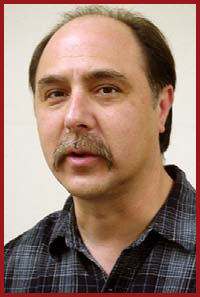
Don José Antonio Esquibel, 2000 El Adelantado
José is well known in New Mexico as a lecturer, genealogist and historian. He was born in Santa Fe and has family members from Las Vegas to Santa Cruz. His research and writing have focused on the history and genealogy of New Mexico families. By 2000 he had written over forty articles in various genealogical and historical journals such as, The New Mexico Genealogist, Nuestras Raices and Herencia. José frequently lectures to genealogy groups and presents charts of existing and new information from many sources. He readily shares the information with anyone who asks. In addition, his research into the maternal ancestry of Don Juan de Oñate was published in the Colonial Latin American Historical Review. He contributed to the Seeds of Struggle/ Harvest of faith: the Catholic Church in New Mexico and El Camino Real de Tierra Adentro. With Christine and Douglas Preston, he is co-author of The Royal Road: El Camino Real from Mexico City to Santa Fe and with John B. Colligan has co-authored The Spanish Recolonization of New Mexico. The bible of New Mexico genealogy is Fray Angelico Chavez’s book, Origins of New Mexico Families and José has created a website to publish new information. His writings and continuing research will allow Hispanics to more readily research their family roots. José has produced a reference source of great value. Through his writing he has promoted the Hispanic culture, he has set a positive example and he serves as a role model.
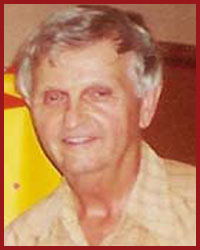
Marc Simmons, 1999 El Adelantado
New Mexico’s best known historian and independent scholar who has published at least forty-three books as well as over 1,400 magazine, newspaper articles, over fifty scholarly articles and seventy-four chapters or introductions in books by other authors. He is internationally recognized as an authority on Spanish Colonial New Mexico, the Santa Fe Trail, the life and times of Kit Carson and the Spanish documentary records that are the source for so many of his writings. He is also known for his determination to write narrative history for general readers rather than speaking strictly to a scholarly audience. A colleague said, “His writing always transforms what normally would be a stuffy historical account into a lively story written like an exciting novel. Through his words, you can almost hear the hoof beats of the horses of the conquistadores, wagon wheels creaking across rugged trails and cowboy boots treading across wooden floors. Good historians who are likewise good storytellers are rare, to say the least.” Another said, “Marc’s contributions to Southwestern history have been little short of monumental. He has turned out one significant history after another, for an accumulation that has added enormously to our understanding of the Spanish Borderlands past.” We are fortunate to have had a respected historian that was willing to write about our ancestors and their accomplishments in a factual and unbiased manner. He has guided other writers to do the same by reviewing their manuscripts.
